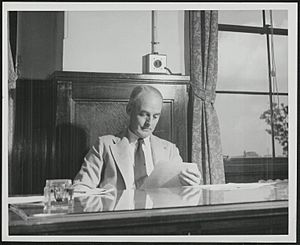William Donald Patrick, Lord Patrick facts for kids
Quick facts for kids
Lord Patrick
PC, FRSE
|
|
|---|---|
 |
|
| Senator of the College of Justice | |
| In office 1939–1963 |
|
| Monarch | |
| Dean of the Faculty of Advocates | |
| In office 1937–1939 |
|
| Preceded by | James Keith |
| Succeeded by | James Gordon McIntyre |
| Personal details | |
| Born |
William Donald Patrick
24 December 1889 Dalry, Ayrshire |
| Died | 17 February 1967 (aged 77) Edinburgh |
| Nationality | Scottish |
| Relations | William Patrick (father); Anne Patrick (mother) |
| Children | 1 |
| Alma mater | University of Glasgow |
| Profession | Advocate |
William Donald Patrick, known as Lord Patrick (born December 24, 1889 – died February 17, 1967), was an important Scottish lawyer and judge. He served as a pilot in the Royal Flying Corps during World War I. After the war, he became a very successful lawyer. In 1939, he was appointed a judge, becoming a Senator of the College of Justice. After World War II, he was one of the judges at the Tokyo Trials. These trials judged Japanese military and political leaders for their actions during the war.
Contents
Early Life and Education
William Patrick was born in a town called Dalry in Ayrshire, Scotland. His father, William Smith Neil Patrick, worked as a sheriff clerk in Ayr. A sheriff clerk helps manage the local court.
William went to the High School of Glasgow. After that, he studied law at the University of Glasgow. He earned his first degree in 1909 and his law degree in 1912.
Military Service in World War I
In 1913, William Patrick became a lawyer, joining the Faculty of Advocates. When World War I started in 1914, he joined the Royal Flying Corps. This was an early air force.
He became a second lieutenant in 1916. Later, he was promoted to captain and then flight commander. In 1917, he joined No. 1 Squadron. He became known as an "air ace" because he shot down seven German aircraft. This happened between October 1917 and March 1918.
On April 10, 1918, his plane was shot down near Messines. He landed behind enemy lines and became a prisoner of war. He was held at a camp called Holzminden.
Legal Career and Judgeship
After the war, William Patrick continued his legal career. He worked for the Scottish Department of Agriculture. In 1929, he became a prosecutor in the local courts.
He became a King's Counsel in 1933. This meant he was a very senior and respected lawyer. His sharp mind and legal skills made him very popular. He worked on many important cases that people were interested in.
In June 1937, he was chosen to lead the Faculty of Advocates. This was a big honor, and everyone was very happy about it.
In 1939, William Patrick became a judge at the Court of Session. He was given the title Lord Patrick. From 1946 to 1948, he represented the United Kingdom at the International Military Tribunal for the Far East. Here, 28 Japanese leaders were tried for their actions during the war.
After returning to Scotland, he continued to serve as a judge. In 1949, he became a Privy Councillor. This is a special group of advisors to the monarch. That same year, Glasgow University gave him an honorary doctorate degree. In 1950, he was also elected a Fellow of the Royal Society of Edinburgh.
Later Life and Death
Lord Patrick passed away in Edinburgh on February 17, 1967. He was 77 years old. He was not married and did not have any children.

